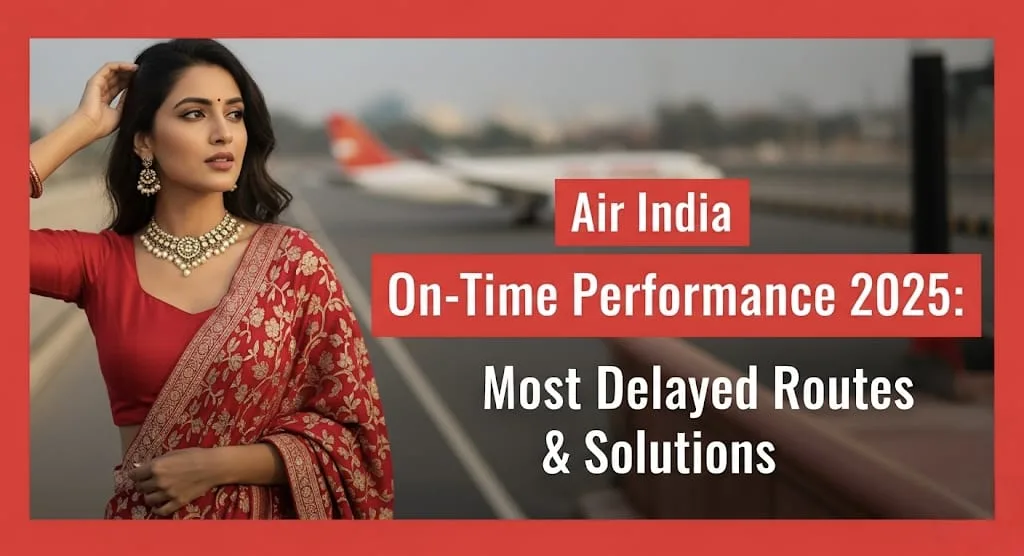In the dynamic landscape of Indian aviation, on-time performance (OTP) remains a critical metric for airlines, directly impacting passenger satisfaction, operational efficiency, and overall brand reputation.
Air India, the nation’s flag carrier, has been under intense scrutiny, particularly after its acquisition by the Tata Group, with a renewed focus on transforming its services. While strides have been made, the airline continues to face challenges, especially concerning flight delays. This in-depth analysis for 2025 delves into Air India’s most delayed routes and explores the multifaceted solutions being implemented and proposed to enhance its punctuality.
The Current State of Air India’s On-Time Performance
As of May 2025, Air India reported an on-time performance (OTP) of 79.7% across six major Indian airports: Delhi, Mumbai, Bengaluru, Hyderabad, Chennai, and Kolkata. While this places them just behind industry leader IndiGo (84% OTP), it signifies a considerable effort to improve punctuality.
However, recent events and continued operational challenges have highlighted areas needing urgent attention. The airline has experienced significant disruptions, including temporary flight reductions and suspensions on numerous routes, both domestic and international, effective until at least July 15, 2025. These measures are a direct consequence of a combination of factors, including enhanced pre-flight safety checks following a recent unfortunate aircraft incident and ongoing airspace restrictions in the Middle East.
Identifying the Most Delayed Routes 📉
While precise real-time data for “most delayed” routes can fluctuate daily due to various operational factors, recent reports and flight schedule adjustments offer significant insights into routes experiencing consistent challenges. Air India’s recent decision to reduce frequency or suspend flights on specific routes strongly indicates where operational pressures and delays have been most pronounced.
Domestic Hotspots for Delays:
- High-Traffic Metro Routes: Routes connecting India’s major metropolitan hubs, such as Delhi-Mumbai, Delhi-Bengaluru, and Mumbai-Bengaluru, frequently witness delays. The sheer volume of traffic, coupled with potential ground handling issues and air traffic control congestion at these busy airports, contributes significantly to these delays. Air India has notably reduced frequencies on these trunk routes (e.g., Delhi-Mumbai from 176x weekly to 165x weekly).
- Tier-2 City Connections: Routes like Mumbai-Bagdogra and Pune-Singapore (which are domestic legs for onward international travel) have seen outright suspension of daily flights until mid-July. This suggests that these routes may have been particularly challenging to maintain on schedule, possibly due to operational efficiencies, aircraft availability, or demand fluctuations.
- Leisure Destinations: Routes to popular tourist spots like Delhi-Goa (Dabolim and Mopa) and Mumbai-Goa have seen a reduction in frequency, often experiencing delays during peak travel seasons due to increased demand and potential airport congestion.
International Routes Under Strain:
- North America and Europe Corridors: Flights connecting Indian metros to North American cities (e.g., Delhi-Toronto, Delhi-San Francisco, Delhi-Chicago) and European destinations (e.g., Delhi-London Heathrow, Delhi-Paris, Bengaluru-London Heathrow) have experienced significant frequency reductions. These routes are particularly vulnerable to delays caused by:
- Airspace Restrictions: Geopolitical tensions and the need to re-route flights to avoid volatile airspace in the Middle East and Persian Gulf have led to longer flight durations and increased fuel consumption, directly impacting schedules and causing knock-on delays.
- Aircraft Availability and Maintenance: The airline has been grappling with higher turnaround times for its Boeing 787 and 777 aircraft, partly due to enhanced pre-flight safety checks following recent incidents. This directly affects the ability to maintain a tight schedule on long-haul routes requiring these wide-body aircraft.
- Specific Suspended International Services: Routes such as Amritsar-London (Gatwick) and Goa (Mopa)-London (Gatwick) have been temporarily suspended, indicating severe operational difficulties in maintaining their schedule. The Delhi-Nairobi route also saw temporary suspension.
Root Causes of Delays: A Multifaceted Problem 🕵️♀️
Understanding the reasons behind these delays is crucial for formulating effective solutions. Air India’s delays can be attributed to a combination of internal operational issues and external environmental factors.
- Technical and Maintenance Issues:
- Aging Fleet Concerns: Despite ongoing modernization efforts, parts of Air India’s fleet still require significant maintenance. A lack of spare parts in the past led to aircraft being grounded, directly impacting schedule integrity.
- Enhanced Safety Checks: Following the recent Ahmedabad plane incident, the Directorate General of Civil Aviation (DGCA) has mandated enhanced surveillance of Air India’s Boeing 787 fleet. While crucial for safety, these rigorous pre-flight checks naturally extend turnaround times, causing delays. Recent incidents like a Tokyo-Delhi flight diverting due to air-conditioning trouble and a Mumbai-Bangkok flight being delayed due to hay found stuck in the wing highlight ongoing technical and maintenance challenges.
- Operational Inefficiencies:
- Crew Shortages and Duty Time Limitations (FDTL): Instances like the cancellation of the Toronto-Delhi flight due to extended maintenance leading to crew exceeding regulatory flight duty time limitation norms underscore a potential gap in crew management and rostering.
- Ground Handling Delays: Inefficient ground handling, including slower baggage loading/unloading, catering, and refueling, can significantly impact aircraft turnaround time, a crucial factor for on-time departures.
- Network Synchronization: Delays on one flight can have a cascading effect across the entire network, especially for an airline with an extensive route map and connecting flights.
- External Factors:
- Air Traffic Congestion: India’s rapidly growing air passenger traffic puts immense pressure on airport infrastructure and air traffic control (ATC). Congestion at major hubs like Delhi and Mumbai leads to holding patterns and delayed clearances.
- Adverse Weather Conditions: Fog, heavy rains, and other inclement weather continue to be significant disruptors, especially during monsoon and winter seasons, leading to diversions and cancellations.
- Geopolitical Tensions and Airspace Restrictions: The ongoing need to reroute flights due to conflicts in the Middle East and other regions directly impacts flight paths, increasing travel time and fuel burn, which in turn affects scheduling and potentially contributes to delays.
- Airport Infrastructure Limitations: While new airports and expansions are underway, some existing airports struggle to handle the growing volume of flights, leading to delays on the ground.
Solutions and Forward-Looking Strategies 💡
Air India, under the guidance of the Tata Group, is actively working on a multi-pronged approach to address its on-time performance challenges.
- Fleet Modernization and Expansion:
- New Aircraft Inductions: The ongoing induction of new, state-of-the-art aircraft, including Airbus A350s, is crucial. Newer planes are generally more reliable, require less frequent maintenance, and offer better fuel efficiency.
- Spare Parts Inventory: A robust supply chain for spare parts and components is being established to minimize ground time for maintenance issues.
- Technological Integration and Digital Transformation:
- Predictive Maintenance: Implementing data analytics and AI-driven predictive maintenance systems can help identify potential issues before they cause breakdowns, allowing for scheduled maintenance rather than reactive repairs.
- Enhanced Communication Platforms: Real-time communication tools between various operational units (pilots, ground crew, maintenance, ATC) can streamline processes and enable quicker decision-making to mitigate delays.
- Automated Processes: Initiatives like self-check-in, automated baggage drop, and automated boarding processes aim to reduce passenger processing time and improve aircraft turnaround.
- Operational Efficiency Enhancements:
- Optimized Crew Rostering: Investing in advanced crew management systems to ensure optimal rostering, minimize fatigue, and prevent delays due to crew exceeding FDTL.
- Improved Ground Handling Partnerships: Working closely with ground handling agencies to enhance their efficiency, provide necessary training, and implement stricter service level agreements to ensure faster turnaround times.
- Hub and Spoke Optimization: Refining the network design to minimize cascading delays, potentially by adjusting flight timings and connections at major hubs.
- Safety and Regulatory Compliance:
- Adherence to DGCA Mandates: Strictly adhering to and even exceeding DGCA safety guidelines and enhanced surveillance orders, while concurrently working to make these processes as efficient as possible without compromising safety.
- Continuous Training: Investing in ongoing training for pilots, cabin crew, and ground staff to enhance their skills, efficiency, and preparedness for various operational scenarios.
- Customer-Centric Approach:
- Proactive Communication: Implementing systems for proactive and transparent communication with passengers about potential delays, offering alternatives, and providing compensation where applicable. This helps manage passenger expectations and reduce frustration.
- Robust Customer Support: Strengthening customer service channels to efficiently handle queries, re-bookings, and complaints arising from delays.
Key Highlight Features
| Feature | Description | Impact on OTP |
| Fleet Modernization ✈️ | Induction of new aircraft (e.g., A350s), phasing out older planes. | Reduces technical snags, improves reliability, potentially faster turnaround. |
| Enhanced Safety Checks ✅ | Rigorous pre-flight inspections, particularly on Boeing 787s, post-incident. | Initially extends turnaround times, but crucial for long-term safety and trust. |
| Airspace Re-routing 🌍 | Adjusting flight paths to avoid volatile regions, especially in the Middle East. | Increases flight duration, fuel consumption, and can lead to scheduling adjustments. |
| Ground Handling Optimization 👷♀️ | Focus on streamlining ground operations, including baggage, catering, and refueling. | Accelerates aircraft turnaround time, reducing delays at the gate. |
| Crew Management Systems 🧑✈️ | Advanced rostering to prevent Flight Duty Time Limitations (FDTL) breaches. | Ensures availability of rested crew, preventing delays due to regulatory limits. |
| Digital Transformation 💻 | Implementation of self-check-in, automated baggage drop, predictive maintenance. | Improves passenger flow, reduces manual errors, anticipates and prevents technical issues. |
| Customer Communication 🗣️ | Proactive updates on delays, alternative flight options, and compensation. | Manages passenger expectations, reduces frustration, and enhances trust. |
The Road Ahead: A Commitment to Punctuality
Air India’s journey towards consistent on-time performance is a complex one, intertwined with its larger transformation agenda. While challenges like geopolitical tensions, infrastructure constraints, and the aftermath of recent incidents continue to exert pressure, the airline’s commitment to safety and operational efficiency is paramount. The current flight reductions, though inconvenient for passengers, underscore a strategic decision to prioritize schedule integrity and safety over maintaining a stretched operation.
The airline’s focus on technological adoption, fleet renewal, and process optimization signals a long-term vision for sustained improvement. As Air India continues its integration with other Tata Group aviation entities, there is potential for further synergy in resource allocation, maintenance, and network planning, which could significantly benefit its OTP.
For passengers, the impact of these changes will be felt in the coming months. While short-term disruptions may persist, the strategic adjustments aim to build a more reliable and punctual airline in the long run. The industry, and particularly the travelling public, will be closely watching Air India’s progress as it navigates these complexities, striving to become a global benchmark for punctuality and service excellence. The goal is clear: to ensure that every Air India flight takes off and lands on time, every time, building trust and delivering a seamless travel experience.
Frequently Asked Questions (FAQs) 🤔
Q1: Why is Air India experiencing so many delays in 2025?
A1: Air India’s delays in 2025 are attributed to a combination of factors including enhanced pre-flight safety checks on its Boeing 787 fleet after a recent incident, geopolitical tensions causing airspace re-routing and longer flight durations, and ongoing efforts to overcome historical operational inefficiencies related to maintenance and crew management.
Q2: What are the most affected routes by Air India delays?
A2: While specific daily delays vary, routes that have seen recent frequency reductions or temporary suspensions are generally the most affected. These include high-traffic domestic routes like Delhi-Mumbai, Delhi-Bengaluru, and Mumbai-Bengaluru, as well as international long-haul routes to North America (e.g., Delhi-Toronto, Delhi-San Francisco) and Europe (e.g., Delhi-London, Bengaluru-London) due to operational adjustments and airspace issues.
Q3: What is Air India doing to improve its on-time performance?
A3: Air India is undertaking several initiatives, including fleet modernization with new aircraft, implementing enhanced safety protocols, optimizing crew rostering, improving ground handling efficiency, investing in digital transformation for predictive maintenance and automated processes, and enhancing customer communication regarding potential disruptions. The current flight schedule adjustments are also part of a strategy to improve overall schedule integrity.


